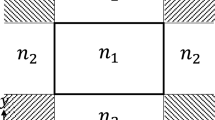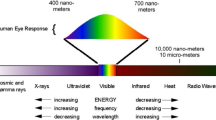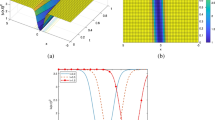Abstract:
A planar open dielectric waveguide with periodic rectangular corrugations is investigated in the case that surface wave is guided and propagates normally to the corrugation. Our approximate analysis with the propagation characteristics is to consider a corresponding bounded waveguide problem in which perfect electric or magnetic walls are introduced, and the periodic corrugation is regarded as consisting of step discontinuities connected by a length of uniform slab waveguide. By properly taking into account of both surface modes and only a few non-surface-modes, and using conservation of complex power technique (CCPT) as well as solution selection rule (SSR), we can readily derive propagation characteristics in the Bragg interaction region. The calculated results show an excellent agreement with previously published ones.
Similar content being viewed by others
References
[1] Elachi, “Waves in active and passive periodic structure: A review,” Proc. IEEE, vol. 64, pp. 1666–1698, 1976.
[2] S. T. Peng, T. Tamir, and H. L. Bertoni, “Theory of periodic dielectric waveguides,” IEEE Trans. Microwave Theory Tech., vol. MTT-23, pp. 123–133, 1975.
[3] T. Tamir, and S. Zhang, “Modal transmission-line theory of multilayered grating structures,” J. Lightwave Technol., vol.14, pp. 914–927, 1996.
[4] H. Stoll, and A. Yariv, “Coupled-mode analysis of periodic dielectric waveguides,” Opt. Commun., vol. 5, pp. 325–328, 1975.
[5] K. Handa, S. T. Peng, T. Tamir, “Improved perturbation analysis of dielectric gratings,” Appl. Phys., vol. 5, pp. 325–328, 1975.
[6] S. Zhang, and T. Tamir, “Analysis and design of broadband grating couplers,” IEEE J. Quantum Electron., vol. 26, pp. 2813–2824, 1993.
[7] T. E. Rozzi, “Rigorous analysis of the step discontinuity in a planar dielectric waveguides,” IEEE Trans. Microwave Theory Tech., vol. MTT-26, pp. 738–746, Oct. 1978.
[8] T. E. Rozzi and G. H. In'tveld, “Field and network analysis of interacting step discontinuities in planar dielectric waveguides,” IEEE Trans. Microwave Theory Tech., vol. MTT-27, pp. 303–309, Apr. 1979.
[9] G. H. Brooke and M. M. Z. Kharadly, “Scattering by abrupt discontinuities on planar dielectric waveguides,” IEEE Trans. Microwave Theory Tech., vol. MTT-30, pp. 760–770, 1982.
[10] H. Shigesawa, and M. Tsuji, “A new equivalent network method for analyzing discontinuity prosperities for open dielectric waveguides,” IEEE Trans. Microwave Theory Tech., vol. MTT-37, pp. 3–14, Jan. 1989.
[11] R. Safavi-Naini and R. H. MacPhic, “On solving waveguide junction scattering problem by the conservation of complex power technique,” IEEE Trans. Microwave Theory Tech., vol. MTT-29, pp. 337–343, Apr. 1981.
[12] ———, “Scattering at rectangular-to-rectangular waveguide junctions,” IEEE Trans. Microwave Theory Tech., vol. MTT-30, pp. 2060–2063, Nov. 1982.
[13] S. T. Peng and A. A. Oliner, “Guidance and leakage properties of a class of open dielectric waveguides: Part 1 — Mathematical formulations,” IEEE Trans. Microwave Theory Tech., vol. MTT-29, pp. 843–855, Sept. 1981.
[14] M. Tsuji, S. Matsumoto, H. Shigesawa, and K. Takiyama, “Guided-wave experiments with dielectric waveguides having finite periodic corrugation”, IEEE Trans. Microwave Theory Tech., vol. MTT-31, pp. 337–343, Apr. 1981.
[15] S. T. Peng, J. M. Dong, and L. M. Wang, “Wave interaction in doubly periodic structure”, in 1985 IEEE MTT-S Microwave Symp. Dig., June 1985, 131–134.
[16] R. E. Collin, Field Theory of Guided Waves. New York: McGraw-Hill, 1960, ch.8.
[17] D. Marcuse, Light Transmission Optics, 2nd ed. New York: Van Nostrand Reinhold, 1982, ch.8.
[18] T. Tamir, “Beam and waveguide couplers,” in Integrated Optics, T. Tamir, Ed. 2, New York: Springer-Verlag, pp. 83–137, 1985.
Author information
Authors and Affiliations
Rights and permissions
About this article
Cite this article
Huikan, L., Tianlin, D. Guidance of Surface Waves with Dielectric Waveguides Having Finite or Infinite Periodic Corrugations. Int J Infrared Milli Waves 26, 1389–1406 (2005). https://doi.org/10.1007/s10762-005-8437-0
Received:
Published:
Issue Date:
DOI: https://doi.org/10.1007/s10762-005-8437-0




